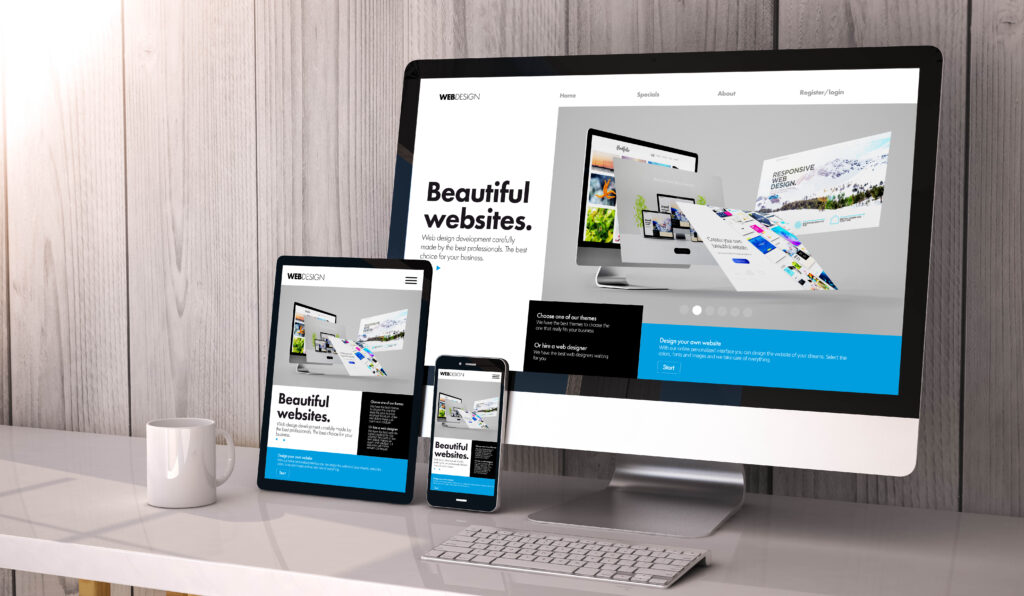Introduction to Website Builders
In the current digital landscape, having an online presence is essential for various entities, including businesses, freelancers, and enthusiasts. One common question that arises is, “how much it cost to use Website Builder?” Website builders have become a popular solution due to their ease of use and the ability to create visually appealing and functional websites without needing in-depth coding skills. They provide a platform that simplifies the website creation process, making it accessible to individuals with varying levels of technical expertise.
Website Builders come with a variety of features designed to aid users in building their websites. These platforms typically offer drag-and-drop functionality, pre-designed templates, and an array of customisation options. Such features allow users to personalise their websites to reflect their brand or personal style. Moreover, website builders often include integrated tools for SEO, social media, and analytics, which are crucial for driving traffic and understanding user engagement.
One of the significant advantages of using a Website Builder is the ability to manage your website without relying on a web developer. This independence can lead to cost savings and faster updates, as you can make changes whenever necessary. The platform’s user-friendly interface enables even those with limited technical skills to create and maintain a professional-looking website.
When contemplating the cost of Website Builders to build websites, it’s essential to recognise that pricing varies widely. The cost depends on several factors, including the platform chosen, the features required, and any additional services you might need. Monthly subscription fees are common, but many website builders also offer free plans with certain limitations. Paid plans generally provide more advanced features, higher storage limits, and the removal of ads.
Website Builders are particularly advantageous for small businesses and start-ups with limited budgets. They eliminate the need for significant upfront investment in web development, allowing you to allocate resources more effectively. Additionally, many website builders offer e-commerce capabilities, enabling businesses to sell products and services directly through their websites.
Apart from businesses, Website Builders are beneficial for freelancers and creatives who need an online portfolio to showcase their work. The platforms allow for quick and easy updates, ensuring that your portfolio remains current and reflective of your latest projects.
It’s also worth noting the importance of choosing a Website Builder that aligns with your specific needs. Some platforms cater more towards e-commerce, while others might be better suited for blogging or showcasing portfolios. Assessing the available features and determining which ones are essential for your website’s goals can help you make an informed decision.
The rise of mobile usage further emphasises the importance of Website Builders that offer responsive design. A significant portion of web traffic now comes from mobile devices, and a website that looks good and functions well on both desktops and mobiles can significantly enhance user experience and engagement.
Basic Costs of Website Builders
When considering the cost of a Website Builder to build websites, the basic expense often involves a monthly subscription fee. These fees can vary significantly depending on the platform and the features offered. For example, Wix’s premium pricing plans range from $17 to $159 per month, billed annually. Similarly, Weebly offers pricing plans that range from $10 to $26 per month, billed annually. On the other hand, Squarespace’s pricing plans vary from $16 to $52 per month, also billed annually.
Free versus paid plans is another crucial consideration. Many Website Builders provide free plans, but these often come with limitations such as storage caps, ads, and restricted features. It’s vital to weigh the benefits of paid plans against the restrictions of free options to determine which best meets your needs.
The features and services included in these subscription fees can also differ greatly. Basic plans usually cover fundamental website building tools such as templates, drag-and-drop editors, and basic customer support. As you move to higher-tier plans, additional services like advanced analytics, enhanced security features, and premium customer support become available.
Another aspect to consider is the cost of e-commerce capabilities. If you plan to sell products or services online, you’ll likely need a more expensive plan that includes e-commerce features. For instance, Wix’s Core plan, which unlocks e-commerce options, costs $29 per month. This makes it an attractive option for those interested in selling products online. On the other hand, Weebly allows users to sell for free on its plan, making it one of the only builders to offer this feature. For those considering Squarespace, the Business plan, which includes e-commerce, is priced at $23 per month.
Additionally, Website Builders often have various add-ons and premium services that can incur extra costs. These may include advanced SEO tools, marketing tools, or integrations with third-party services. While these features can significantly enhance your website’s functionality and reach, they also add to the overall cost.
It’s also important to note the cost of domain name registration. While some builders offer a free custom domain for the first year, renewal fees are typically charged annually.
Additional Expenses to Consider
Beyond the basic monthly fees, there are other costs associated with building a website using a Website Builder. Domain name registration is one such cost. While some builders offer a free custom domain for the first year, renewal fees are typically charged annually.
Additionally, you might want to invest in premium templates and features to enhance the aesthetics and functionality of your website. It’s important to note that Wix’s free plan includes limitations such as banner ads, only 500MB of storage, and no custom domain. Similarly, Weebly’s free plan comes with restrictions like a 500MB storage limit, Square Online ads, and no custom domain.
Besides the limitations on free plans, opting for premium features often entails additional charges. Advanced functionalities such as enhanced security measures, marketing tools, and third-party integrations can be beneficial but also contribute to increased expenses. Many website builders provide basic SEO tools, but for more comprehensive SEO features, an upgrade to a higher-tier plan or purchasing add-ons might be required.
E-commerce capabilities also come with additional costs. If your website aims to sell products or services, you’ll likely need a more expensive plan that includes e-commerce features. While basic plans might allow for limited e-commerce functionalities, advanced options like payment gateways, inventory management, and customer reviews generally come with higher costs.
Another factor to consider is the cost of hiring external help. Although Website Builders are designed to be user-friendly, some users may still require professional assistance for tasks such as custom coding or graphic design. Freelancers or agencies can offer these services, but their fees will add to the overall cost of website creation.
Email marketing is another area that could incur extra expenses. While some website builders include basic email marketing tools, advanced features such as automated campaigns, detailed analytics, and higher email sending limits often require additional payments.
Website maintenance is another crucial aspect that can lead to additional costs. Regular updates, backups, and security checks are essential for keeping your site running smoothly and securely. Some website builders offer these services as part of their higher-tier plans, but in other cases, you may need to pay for them separately.
The choice of templates can also affect the overall cost. While many Website Builders offer a range of free templates, premium templates with more sophisticated designs and customisation options usually come at an extra cost. Investing in a premium template can give your website a more polished and unique appearance, which can be especially important for businesses looking to establish a strong brand identity.
Additionally, the cost of integrating third-party tools and services should not be overlooked. Popular integrations might include customer relationship management (CRM) systems, advanced analytics tools, or social media platforms. These integrations often have their own subscription fees, which can add up over time.
Comparing Popular Website Builders
Choosing the right Website Builder involves comparing the pricing and features offered by different platforms. For instance, Wix’s Core plan, which unlocks ecommerce options, costs $29 per month. This makes it an attractive option for those interested in selling products online. On the other hand, Weebly allows users to sell for free on its plan, making it one of the only builders to offer this feature. For those considering Squarespace, the Business plan, which includes ecommerce, is priced at $23 per month.
Each platform’s features included in different pricing tiers vary, affecting the overall website creation cost using a website builder. It’s essential to assess what each tier offers and how it aligns with your website’s objectives. For example, Wix provides a range of plans with different features. Their basic plan, starting at around $14 per month, includes essential tools like drag-and-drop editors and basic customer support. Higher-tier plans offer advanced features such as enhanced storage, premium customer support, and integrated marketing tools. Additionally, Wix’s Core plan provides e-commerce functionalities for $29 per month, catering to those looking to sell products online.
Weebly, known for its simplicity, offers plans that range from free to $26 per month. While their free plan has limitations, such as 500MB storage and Square Online ads, their paid plans unlock additional features. Weebly’s Pro plan, priced at $12 per month, includes advanced site stats, password protection, and video backgrounds. Their Business plan, at $25 per month, includes e-commerce functionalities, such as an integrated shopping cart and payment options, making it a suitable choice for small businesses.
Squarespace is another popular choice, especially for those looking for a polished and professional website. Their plans range from $12 to $40 per month, with the Personal plan at $12 per month offering essential tools and templates. The Business plan, priced at $23 per month, includes advanced analytics, promotional pop-ups, and e-commerce capabilities. For those needing more robust e-commerce features, the Basic Commerce plan at $27 per month and the Advanced Commerce plan at $40 per month provide features like abandoned cart recovery and advanced shipping.
Shopify is a platform specifically tailored for e-commerce, offering plans from $29 to $299 per month. Their Basic Shopify plan, at $29 per month, includes unlimited products, two staff accounts, and manual order creation. The Shopify plan, priced at $79 per month, adds features like gift cards and professional reports. The Advanced Shopify plan, at $299 per month, includes advanced report building and third-party calculated shipping rates, making it ideal for larger businesses with more complex needs.
BigCommerce is another e-commerce-focused platform with plans ranging from $29.95 to $299.95 per month. Their Standard plan, at $29.95 per month, includes unlimited products, file storage, and bandwidth. The Plus plan, priced at $79.95 per month, adds customer segmentation and abandoned cart recovery. The Pro plan, at $299.95 per month, includes advanced reporting tools and Google customer reviews.
While all these platforms offer a variety of features, it’s important to consider your specific needs and budget when making a choice.
Hidden Costs and Common Surprises
Even with clearly outlined pricing plans, Website Builders often have hidden costs that can catch users off guard. One unexpected charge might come from exceeding the allocated storage limits of your chosen plan. For example, a basic plan might include 500MB to 1GB of storage, but if you upload high-resolution images or videos, you could quickly surpass this limit and incur additional fees for extra storage space.
Another hidden cost to consider is the need for additional plugins or third-party integrations. While many Website Builders offer a range of built-in features, you might find yourself needing more specialised tools to enhance your site’s functionality. These can include advanced SEO tools, enhanced security measures, or marketing automation software. These integrations often come with their own subscription fees, adding to the overall cost of maintaining your website.
Upgrading to more advanced features can also lead to unforeseen expenses. Basic plans often come with limitations that might not be immediately apparent. For instance, a low-tier plan might restrict the number of products you can list on your e-commerce site, or limit the amount of traffic your site can handle. As your website grows and your needs evolve, you might find it necessary to upgrade to a higher-tier plan, which can be significantly more expensive.
Email marketing is another area where hidden costs can emerge. While some Website Builders include basic email marketing tools, advanced features such as automated campaigns, detailed analytics, and higher email sending limits often require additional payments. If email marketing is a crucial part of your strategy, these costs can add up quickly.
Many website builders offer a free domain for the first year, but renewal fees can be surprisingly high. Domain names typically need to be renewed annually, and while the initial offer might be enticing, the renewal fees can be a costly surprise. Additionally, if you decide to purchase a premium domain name or multiple domains, these costs can escalate even further.
Customising your website to reflect your brand identity might also incur extra expenses. Many website builders offer a range of free templates, but premium templates with more sophisticated designs and customisation options usually come at an extra cost. Investing in a premium template can give your website a more polished and unique appearance, but it’s important to factor this into your budget.
Customer support is another area where costs can be higher than anticipated. Basic plans often come with limited support options, such as email support or access to a help centre. However, if you require more immediate or specialised assistance, such as phone support or access to a dedicated account manager, you might need to upgrade to a more expensive plan.
Additionally, some Website Builders charge for advanced analytics and reporting tools. Basic analytics might be included in lower-tier plans, but more detailed insights often come with a price tag. These advanced tools can be invaluable for understanding user behaviour and optimising your site, but they can also add to your monthly expenses.
If you’re using your website for e-commerce, payment processing fees are another hidden cost to consider. While the Website Builder itself might offer e-commerce capabilities, each sale you make will likely incur a transaction fee. These fees can vary depending on the payment gateway you choose and the volume of transactions you process, and they can significantly impact your profit margins.
Regular maintenance is essential for keeping your website running smoothly and securely, but it can also be a hidden expense. Some website builders offer maintenance services as part of their higher-tier plans, but in other cases, you may need to pay for these services separately. This can include regular updates, backups, and security checks, all of which are crucial for the long-term health of your site.
Finally, hiring external help for tasks like custom coding or graphic design can add to your overall costs. While website builders are designed to be user-friendly, you might still require professional assistance to achieve a specific look or functionality. Freelancers or agencies can offer these services, but their fees will increase your website creation budget.
Understanding these potential hidden costs can help you make a more informed decision and better manage your budget when using a Website Builder.
Tips for Saving Money
Choosing the right plan for your website needs is a crucial step in managing costs effectively. Begin by identifying the core features you need and avoid splurging on unnecessary add-ons that may seem appealing but are not essential for your site’s functionality. Thoroughly comparing different website builders can help you select the one that offers the best value for your specific requirements.
Many Website Builders offer discounts and promotional deals at various times of the year. These can significantly reduce your expenses, especially when opting for annual subscriptions instead of monthly payments. Signing up for newsletters or following the platforms on social media can keep you informed about these deals.
Starting with a free plan or the most basic paid plan allows you to experiment with the platform without making a significant financial commitment. This approach provides the opportunity to understand the tool’s capabilities and limitations. As your website evolves, you can then upgrade to a more advanced plan that meets your expanding needs, ensuring you only pay for features when you actually need them.
While free plans often come with limitations like storage caps and ads, they can be a good starting point, especially for personal projects or small-scale websites. As your website gains traction and your needs become more sophisticated, gradually upgrading can ensure that your expenses grow proportionately with your website’s success.
Utilising the built-in tools and features offered by your chosen Website Builder can also save you money. Many platforms include basic SEO tools, social media integration, and analytics as part of their packages. Fully leveraging these tools can eliminate the need for third-party services, thus reducing additional costs.
Selecting a template that suits your needs from the get-go can prevent unnecessary expenditures on premium templates or custom designs. Many website builders offer a range of free, high-quality templates that can be customised to reflect your brand identity without additional costs. If you do require a more polished look, opting for a premium template can be a worthwhile investment, but ensure it fits within your budget constraints.
For e-commerce websites, carefully consider the payment processing fees and transaction costs associated with different builders. Some platforms offer more competitive rates or include these fees in their plans. Researching and comparing these fees can help you select the most cost-effective option for your online store, ultimately saving you money on each transaction.
Email marketing tools are often available as part of higher-tier plans or as add-ons. If email marketing is essential for your strategy, look for platforms that offer these tools at a reasonable cost. Alternatively, you can explore third-party email marketing services that might provide better value for money while still integrating seamlessly with your website builder.
Regular maintenance, backups, and updates are essential for keeping your site secure and running smoothly. Some website builders include these services in their higher-tier plans, but if yours doesn’t, consider performing these tasks manually or using affordable third-party services to handle them.
If your website requires specific functionalities that aren’t available in your chosen Website Builder, consider hiring freelancers for custom coding or design tasks. Platforms like Upwork or Fiverr offer access to a wide range of professionals at competitive rates, allowing you to get the necessary help without committing to the higher costs of an agency.
Finally, engaging with online communities and forums can provide valuable insights and tips for saving money. Other users often share their experiences, including cost-saving strategies and recommendations for tools and services that offer the best value.
By adopting a strategic approach and being mindful of your needs, you can effectively manage the website creation cost using a Website Builder while still achieving a professional and functional online presence.



